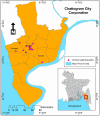Prevalence and risk factors of antimicrobial resistance patterns of Staphylococcus spp. and E. coli in rodents and shrews at human-animal interfaces in Chattogram, Bangladesh
- PMID: 40638611
- PMCID: PMC12244769
- DOI: 10.1371/journal.pone.0327857
Prevalence and risk factors of antimicrobial resistance patterns of Staphylococcus spp. and E. coli in rodents and shrews at human-animal interfaces in Chattogram, Bangladesh
Abstract
Antimicrobial resistance (AMR) poses a significant threat to human and animal health worldwide. Wild rodents and shrews may serve as bioindicators of environmental health. They may serve as a potential source of the transmission of AMR bacterial infections to humans and domestic animals, despite not directly consuming antibiotics. We conducted a cross-sectional study aimed to estimate the prevalence and factors associated with the AMR patterns in Staphylococcus spp. and Escherichia coli (E. coli) isolated from rodents and shrews. We trapped and collected throat and rectal/urine swab samples from 200 wild rodents (n = 115) and house shrews (n = 85) across different locations in Chattogram, Bangladesh. The collected samples were then evaluated for the isolation of both bacterial organisms using culturing and biochemical properties. We performed culture sensitivity (CS) tests of the isolates using the Kirby-Bauer disc diffusion method for 14 antimicrobials. The overall prevalence of Staphylococcus spp. was 26.5% (95% CI: 0.20-0.33; n = 53), and E. coli was 56% (95% CI: 0.49-0.63; n = 112) in the sampled rodents and Asian house shrews. Staphylococcus spp. isolates were 100% resistant to oxacillin, oxytetracycline, metronidazole, and cefixime. Again, E. coli isolates were 100% resistant to metronidazole followed by ampicillin and cefixime (98.0%), sulfamethoxazole + trimethoprim (97.0%), amoxicillin and doxycycline (96.0%), streptomycin (95.0%). Only gentamycin was sensitive against both bacterial isolates. Statistical modeling revealed a higher risk of resistant bacterial infection in rodents from agricultural interfaces compared to other habitats. Rodents and Asian house shrews with poor body condition were more prone to resistant Staphylococcus spp. infection, while rodents were more susceptible to resistant E. coli infection. Our findings indicate a significant prevalence of AMR Staphylococcus spp. and E. coli in urban rodents and house shrews, suggesting their potential role as reservoirs and disseminators of AMR, hence posing a risk to human and animal health.
Copyright: © 2025 Rumi et al. This is an open access article distributed under the terms of the Creative Commons Attribution License, which permits unrestricted use, distribution, and reproduction in any medium, provided the original author and source are credited.
Conflict of interest statement
The authors have declared that no competing interests exist.
Figures









References
-
- Wilson DE, Reeder DM. Mammal species of the world: a taxonomic and geographic reference. 1 ed. 2005.
-
- Feeroz MM. Red list of Bangladesh: mammals. International Union for Conservation of Nature (IUCN), Bangladesh; 2015. 4–5.
-
- Islam S, Rahman MK, Ferdous J, Rahman M, Akter S, Faraque MO. Hemoprotozoa and Anaplasma spp. in rodents and shrews of Bangladesh. 2020. - PubMed
MeSH terms
Substances
LinkOut - more resources
Full Text Sources
Medical
Miscellaneous

